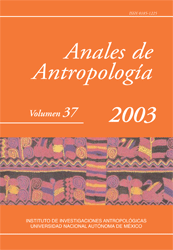La muerte de una joven en parto y su significado en la vida lacustre: El entierro 5 en el islote 20, la Ciénaga de Chignahuapan, Estado de México
Main Article Content
Abstract
At around the Terminal Classic (550-600/650 AD), many man-made islands were constructed at the lakeshore of the Chignahuapan Marsh, Upper Lerma Basin, located in the present town named Santa Cruz Atizapan, state of México. The construction of these small islands reached to its apogee during the subsequent Epi-Classic Period (700-900 AD). The island inhabitants developed a complex mode of life based on a tight relationship with their lacustrian surroundings. In effect, the life of these islanders was pending to a fragile and delicate equilibrium and positive interaction with the lacustrain conditions, which were necessary to their survival as human group. Recent archaeological explorations conducted on one of these islands of the site unearthed many important data that revealed the core aspects of this particular life mode, in which aquatic and lacustrian rituals had an undeniable importance. One of the evidences referring to this is a burial of a young woman excavated in the year 2000 who, apparently, died during the childbirth. This article concerns with the above mentioned burial which presents unique characteristics of nearly 60 burials excavated in this artificial island, as well as strong implication of the aquatic rituals.
Downloads
Download data is not yet available.
Article Details
How to Cite
Sugiura Y., Y., Torres Sanders, L., Covarrubias G., M., & de Ángeles G, M. (2010). La muerte de una joven en parto y su significado en la vida lacustre: El entierro 5 en el islote 20, la Ciénaga de Chignahuapan, Estado de México. Annals of Anthropology, 37(1). https://doi.org/10.22201/iia.24486221e.2003.1.16727
Citas en Dimensions Service
Esta revista usa una licencia CC del tipo CC BY-NC-ND 3.0. Se maneja bajo el esquema de acceso abierto, con una licencia Creative Commons Attribution-NonCommercial-NoDerivs 3.0 Unported.
